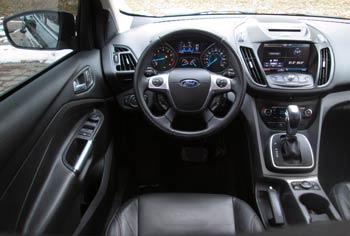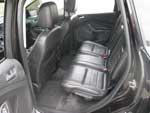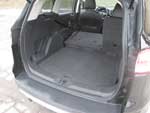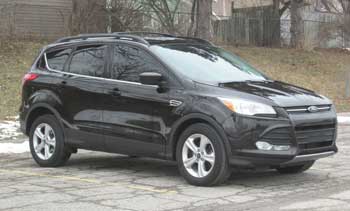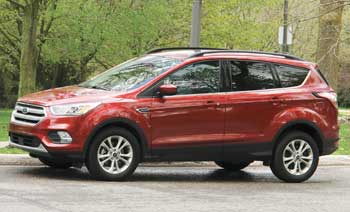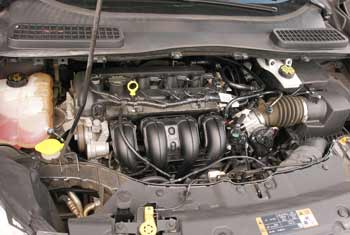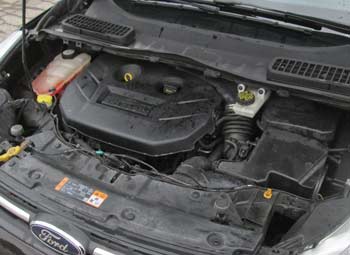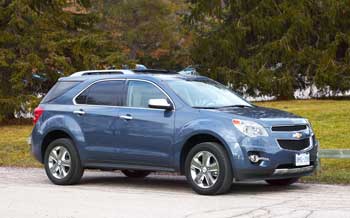Ford Escape 2013-2019: pros and cons, common problems
By Vlad Samarin, updated: February 25, 2023
The third-gen Ford Escape is a sporty 5-seater compact SUV. It offers a solid road feel and a spacious, nicely-finished interior. The North American Ford Escape offers three different 4-cylinder engines and comes with front- or all-wheel drive.
The only transmission choice is a 6-speed automatic.For 2017, the Escape received a minor facelift with a larger front grille, a few interior upgrades and new features, including Auto Start-Stop. The NHTSA overall crash test rating improved from four to five stars out of five.
A used Ford Escape is widely available and is priced moderately compared to other SUVs. What are the pros and cons and common problems? Which engine will last longer and cost less to maintain? Let's start with pros and cons.
Pros:
- Stylish looks, soild feel.
- Spacious interior, good visibility.
- Enjoyable driving experience.
- Priced lower than some other small SUVs.
- Available with a reliable 2.5L non-turbo engine.
- The optional 2.0L turbo engine offers plenty of power and torque.
- EcoBoost engine problems, cooling system issues.
- Transmission problems.
- Will not hold its value as well as the Honda CR-V or Toyota RAV4.
- Lack of storage space in the front.
- Cramped engine compartment makes it difficult to work on.
If you are buying a used Ford Escape, consider getting a good extended warranty for the powertrain with no limit per claim. The 2.5L non-turbo engine is the least troublesome. Let's look at some of the problems:
As of May 2022, there were 1044 complaints about the 2013 Escape engine on the NHTSA website. The majority of complaints are related to the 1.6L engine stalling and overheating. Ford issued the recall 13S12 to address the issue. Some Escape owners reported that the 1.6L engine overheats even after the recall, see this thread at the FordEscape.org forum.
Given that many EcoBoost engine problems are caused by overheating, it's important to keep the engine coolant at the proper level and to have the vehicle checked out if the overheating warning pops up or if there are any signs of coolant leaks. Common sources of coolant leaks in the 1.6L engine include the water pump, coolant expansion reservoir and the heater hose (the one with the "T" joint above the transmission). We found many Youtube videos describing the problem and repairs.
There is also a number of complaints about the transmission, especially in the 2013 and 2014 Escape. One of the possible problems with the transmission is a low fluid level caused by a leaking driver-side front axle seal. According to the bulletin 16-0043, the bushing and the seal will have to be replaced ($250-$370 repair if out of warranty). The halfshaft might need to be replaced too if worn out, which will cost extra for the part. If the transmission has failed completely, replacing it with a used unit will cost from $1,700 to $2,900.
The recall 14S17 addressed the problem with the wiring harness in the 2.0L GTDI engine of the 2013-2014 Escape that can cause various driveability problems including stalling. Check for recalls at the NHTSA website.
The code P0234 can be caused by a sticking turbo boost control valve/solenoid, cracked vacuum line or a bad turbocharger bypass valve. The solenoid and a vacuum line are not very expensive to replace. Watch these Youtube videos. The Ford service bulletin 15-0162 for the 2013-2016 Escape with the 1.6L engine mentions the problem with the codes P0234, P0245, P0246 and/or P0299. The bulletin recommends inspecting the charge air cooler tubes and vacuum lines and if they are OK, replacing the turbocharger wastegate regulating valve solenoid (located near the turbocharger).
According to TSB 15-0096, a fuel odor in the 2.0L EcoBoost engine might be originated from the PCV (crankcase ventilation) hose. If the hose fails the inspection, it will have to be replaced.
A coolant bypass solenoid is common to fail and cause the code P26b7. It's a fairly simple repair. We found several YouTube videos on this problem.
A stuck-open or failed EVAP purge valve can cause difficulty starting after a fill-up or the Check Engine light with the code P0455. The purge valve is not very expensive, but it takes some work to replace. Read about repair options for Check Engine light problems
Advertisement
Rear shock absorbers can fail, causing a rattling noise from the back when driving over bumps. Replacing both rear shocks will cost from $170 to $280.
The service bulletin SSM 46965 for the 2013-2018 Escape describes a problem with an AWD system where after extended driving, the vehicle may exhibit a clunk, shuddering or chattering from the rear axle when turning at slow speed. It feels like the rear axle is binding when turning tight corners. According to the bulletin, the solution is to replace the rear drive unit (RDU) viscous coupler clutch with a service kit. We found the service kit (part) is priced from $260 to $290 online without delivery.
Quite a few owners mention various electrical and Sync problems. Some owners reported that the dealer did a hard reset by disconnecting the battery to repair some of the issues.
The audio system may stop working altogether. If it's not a blown Audio fuse, one of the solutions is to replace it with a used audio unit. The warranty is a must in this case, so the used unit can be returned if it doesn't work. Replacing an audio unit takes some labor, but it's not extremely difficult; watch these videos. Another option is to visit a local car electronics shop that might offer an aftermarket audio unit that fits for a reasonable price.
EcoBoost is a direct-injected turbocharged engine. As with all direct-injected engines, the carbon buildup on the intake valves can cause misfiring, hesitation and other driveability issues at higher mileage. We found a few YouTube videos explaining this problem and possible solutions.
Summary: The front-wheel drive Escape with a simple 2.5L non-turbo engine is the most reliable and easy to maintain trim level. The Ecoboost 1.5L turbo engine in the 2017-2019 Escape is more troublesome, although some problems were covered by the warranty. If you are looking for the 1.6L model, the 2015-2016 are the better years; avoid the 2013-2014 1.6L models.
If you are buying a used Ford Escape, consider getting an extended warranty for the powertrain given that most complaints are related to the engine or transmission. Have the vehicle properly inspected before buying to check for coolant leaks and other problems. In the EcoBoost engines, the cooling system needs a particular attention.
As of July 2022, Consumer Reports rated the 2013 and 2017-2019 Escape 'below average' for reliability, while the 2015 Escape had an 'above average' rating. The 2014 and 2016 Escape were rated 'average'.
We spoke to two Escape owners and both praised the driving experience and the overall quality of the vehicle. We also found several 1.6L Escape models for sale with over 200K miles.
2013-2019 Ford Escape Engines:
2.5L Duratec: The base FWD Escape models come with an updated naturally-aspirated (non-turbo) 168-hp 4-cylinder 2.5L Duratec (iVCT I-4, the 8-th digit of the VIN number is "7"). It's a simple workhorse with a conventional multi-port fuel injection. This engine is more reliable and will cost less to maintain in the long run. If you are buying a used Ford Escape, we recommend the 2.5L engine.
1.6L EcoBoost: The 178-hp ("X" on the 8-th digit of the VIN) is an advanced gasoline turbocharged direct-injected (GTDI) motor. It comes standard on the popular SE trim level. As is often the case with smaller turbo engines, it has seen its share of problems in the early model years.
1.5L EcoBoost: (The 8-th digit of the VIN: "D"). It replaced the 1.6L engine for 2017. It's an even smaller engine and Ford managed to squeeze 179 horsepower out of it. It's a modern fuel-efficient engine, but it also has had coolant-related issues. We know Ford repaired many of these engines under warranty.
2.0L EcoBoost: The optional 2.0L-turbo EcoBoost (8-th position of the VIN number is "9") offers 240 horsepower (245 hp from 2017) and 3,500 lbs towing capacity (when equipped with the Tow Package). It's also a gasoline turbocharged direct-injected (GTDI) 4-cylinder engine. Overall, it's a strong motor, but it needs to be maintained well to last and some repairs at higher mileage can be costly. Read also: Pros and cons of buying a car with Direct Injection.
2013-2019 Ford Escape: Timing Belt or Chain: The 2.0L EcoBoost and 2.5L Duratec engines have a timing chain. The 1.6L and the 1.5L EcoBoost have a timing belt.
Timing belt replacement interval: According to the owner's manual for the U.S. 2018 Escape, the recommended timing belt replacement interval for the 1.5L EcoBoost engine is 150,000 miles, which is unusually long. In most other cars, a timing belt is replaced every 100K miles or sooner. The owners manual for the 2016 Escape with the 1.6L engine also suggests replacing the timing belt at 150,000 miles.
EcoBoost engine maintenance tips: To keep your EcoBoost engine in good shape, use high-quality oil, preferably premium synthetic that falls within Ford requirements, and change it more often. It will also help if you replace the engine air filter more frequently; it's not very expensive. Turbocharged engines don't like overheating. Have the coolant level topped up at every oil change and ask to check for any visible leaks. The worst combination for a small turbo engine is driving uphill (or towing) in hot weather with a full load on low-octane gasoline.
Related reviews:
Ford Escape 2008-2012
Ford Edge 2007-2014
Mazda CX-5 2013-2016
Chevrolet Equinox 2010-2017
Honda CR-V 2012-2016
Dodge Journey 2009-2019
Fuel Economy: The 2013-2016 Escape with the 1.6L EcoBoost engine is rated at 22/29 mpg city/highway, giving it a range of up to 378 miles (608 km) on one tank of gas. See ratings of other models in the table.
| Ford Escape EPA fuel economy: | mpg city/hwy |
L/100 km city/hwy |
| 2013 Escape 1.6L turbo FWD | 23/31 | 10.2/7.6 |
| 2014-2016 Escape 1.6L turbo FWD | 23/32 | 10.2/7.4 |
| 2017-2019 Escape 1.5L turbo FWD | 23/30 | 10.2/7.8 |
| 2013-2016 Escape 2.5L FWD | 22/30 | 10.7/7.8 |
| 2013-2016 Escape 1.6L turbo AWD | 22/29 | 10.7/8.1 |
| 2013-2015, 2017, 2019 Escape 2.0L turbo FWD | 22/29 | 10.7/8.1 |
| 2015 Escape 2.5L FWD | 21/30 | 11.2/7.8 |
| 2017-2019 Escape 1.5L turbo AWD | 22/28 | 10.7/8.4 |
| 2017-2019 Escape 2.5L FWD | 21/29 | 11.2/8.1 |
| 2015-2016 Escape 2.0L turbo FWD | 21/29 | 11.2/8.1 |
| 2013-2016, 2018 Escape 2.0L turbo AWD | 21/28 | 11.2/8.4 |
| 2019 Escape 2.0L turbo AWD | 21/27 | 11.2/8.7 |
| 2017-2018 Escape 2.0L turbo AWD | 20/27 | 11.8/8.7 |
